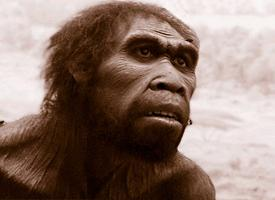
Stav ohrožení
| Vyhynulý |
Popis zvířete
African Homo erectus, often referred to by its synonym Homo ergaster, is a pivotal species in the evolutionary lineage of humans, representing a significant step towards the modern human anatomy and behavior. This early hominin species is believed to have emerged in Africa around 1.9 million years ago, marking a notable departure from its more primitive ancestors through a series of morphological and technological advancements that would lay the groundwork for future human evolution.Physically, Homo ergaster/erectus exhibited a robust stature with a more human-like body proportion compared to its predecessors. One of the most striking features of this species was its increase in brain size, with cranial capacities ranging from about 700 to 1,200 cubic centimeters, suggesting a significant leap in cognitive abilities. This increase in brain size was accompanied by a reduction in the size of the face and jaws, indicating a shift in dietary habits and possibly the use of tools for processing food.
The skeletal structure of Homo ergaster shows evidence of a body built for long-distance walking and running, with longer legs and shorter arms relative to its torso than earlier hominins. This adaptation suggests a lifestyle that included wide-ranging movements across the landscape, possibly in search of food, water, and perhaps even for the purpose of exploration. The discovery of the Nariokotome Boy, a remarkably complete skeleton of a young Homo ergaster individual, has provided invaluable insights into the growth patterns, physical appearance, and lifestyle of this species.
In terms of technology, Homo ergaster is credited with the development of the Acheulean tool culture, characterized by the production of large hand axes and cleavers. These tools represented a significant technological advancement over the simple stone flakes used by their predecessors. The ability to create and use such tools is indicative of advanced cognitive skills, including planning, coordination, and possibly even a rudimentary form of communication. These tools were likely used for a variety of purposes, including butchering animals, processing plant materials, and possibly even in hunting, although the extent to which Homo ergaster engaged in active hunting as opposed to scavenging remains a subject of debate.
Homo ergaster is also notable for its potential role in the use of fire. While definitive evidence for controlled use of fire by this species is still a matter of scientific debate, the discovery of burned bones and plant material in association with Homo ergaster sites suggests that they may have had some knowledge of fire management. The control of fire would have had profound implications for this species, not only in terms of cooking food and making it more digestible and nutritious but also in providing warmth, protection from predators, and a social focal point around which group activities could coalesce.
In summary, African Homo erectus (Homo ergaster) represents a key figure in human evolution, showcasing a suite of anatomical, behavioral, and technological innovations that distinguish it from its predecessors. Its emergence in Africa and subsequent spread across much of the Old World marks a significant chapter in the story of human evolution, shedding light on the complex processes that have shaped the development of modern humans.
Podobná zvířata
Nové fotografie zvířat
Top 10 zvířat
- Chinese water dragon (Physignathus cocincinus)
- Galápagos tortoise (Geochelone nigra complex)
- Dolphin gull (Leucophaeus scoresbii)
- Japanese macaque (Macaca fuscata)
- Colombian red howler (Alouatta seniculus)
- Sea urchins (Echinoidea)
- Moustached guenon (Cercopithecus cephus)
- Diana monkey (Cercopithecus diana)
- Common reed warbler (Acrocephalus scirpaceus)
- Common house mosquito (Culex pipiens)


